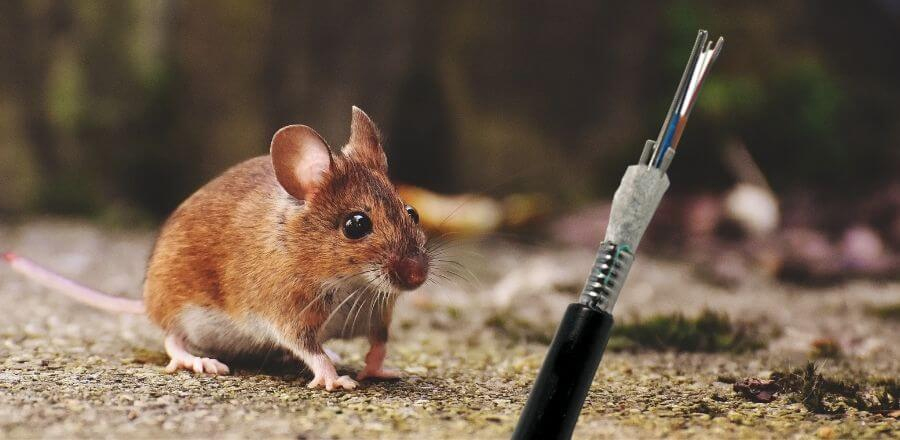Mar. 23, 2022
Rodent and Lightning Protection Measures For outdoor optical Fiber Cables
How to prevent rodents and lightning in outdoor optical cables? With the increasing popularity of 5G networks, the scale of outdoor optical cable coverage and pull-out optical cables has continued to expand. Because the long-distance optical cable uses optical fiber to connect distributed base stations, the base station and the intra-office base station are connected at a distance of 100-300 meters, so that they will not be injured by mice and lightning strikes. Therefore, the problem of rodent and lightning protection of the long-distance optical cable is very important. But at the same time, considering the function of anti-rat and lightning protection, it is also more complicated.
The general anti-rodent function is to put the steel armor tube on the remote optical cable into it, one of which is designed to put the armor tube on the inner layer of the cable jacket, and the other is designed to put the armor tube on the outside of the jacket Floor. However, the armored tube can conduct electricity, and after a lightning strike is introduced into the launch tower, it may be received by the optical fiber assembly, thereby destroying the elongated optical fiber and even causing a fire.
In response to this, steel armor is added to the optical cable sheath, and a flexible wire is added to the lightning protection device to prevent lightning strikes. Cut the fiber outer sheath for a circle along the radial direction, then snap the conductive ring into the incision position, then apply glue to the incision for bonding and sealing, and then add a metal tube to the outer layer for protection. In this way, the high-voltage arc generated by the lightning protection device is absorbed by the armored tube, and a lightning current is generated. Anti-rat, anti-lightning indoor and outdoor fiber optic cable flexible cord can send the generated current into the ground, thereby reducing and avoiding the damage caused by lightning to the optical cable or equipment.

Advantages and Disadvantages of Anti-rodent Optical Cable
Due to factors such as ecological protection and economic reasons, it is not suitable to take measures such as poisoning and hunting to prevent rodents in optical cable lines, and it is also not suitable to adopt burial depth for prevention as directly buried optical cables. Therefore, the current anti-rodent measures for optical cables still need to rely on the structural design and material changes of the optical cables to prevent them. Conventional anti-rodent solutions include adding chemical components to the sheath and adopting multi-layer sheath armor.
The double-layer metal armored structure is used for overhead rodent prevention. The weight and outer diameter of the optical cable are relatively large, which will increase the requirements for overhead poles and towers, which will increase the cost of the optical cable line. Another feasible structure is to use stainless steel strips, but if the stainless steel strips are cut and laminated; the method of adding chemical components is to add capsicum to the cable sheath. Capsaicin was originally a chemical substance extracted from natural substances such as peppers. In a mouse experiment, it was found that mice are more sensitive to hot substances, so it has been regarded as an effective rodent repellent. The commercial capsaicin sheath material is a similar chemical synthetic material added to the polyethylene sheath in a certain proportion.
Since additives may have problems such as water solubility and migration, the migration and water solubility effects in the sheath must be investigated to determine the time effect of this type of optical fiber cable; glass fiber anti-rodent.
Because the glass fiber is extremely thin and brittle, the smashed glass slag will damage the mouth of the rodent during the bite process of the rodent, causing it to fear the optical cable and achieve the effect of preventing rodents; the rodent bite of the optical cable: high strength The steel strips have good rodent resistance, but at the same time, studies have shown that the traces of rodent bites intensify the corrosion of the steel strips exposed to the external environment, and most optical (electric) cables will be corroded within a short period of time. , This is the reason why it is better to adopt stainless steel belt.
The price of fiber optic cable with stainless steel belt will greatly increase the fixed investment of telecommunications facilities. Look for an economical, corrosion-resistant and strong steel belt material to replace the current conventional anticorrosive chrome-plated steel belt; use surrounding steel wire (or non- The structure of the metal reinforcement (GRP) is used to prevent rats, but the small GRP rods (bands) are soft and difficult to withstand the bite of the rats. At the same time, the cost of the optical cable will exceed the glass fiber structure.
The sheath structure of the steel wire wrapping and the entrained steel wire will increase the weight of the optical cable greatly and increase the load-bearing load of the tower; if the corrosion-resistant low-carbon steel wire is used, the optical cable will be very rigid and difficult to coil, which is not conducive to overhead laying; With the use of ordinary high-carbon steel wire structure, the corrosion resistance of the optical cable has become extremely poor. Therefore, these fiber optic cable structures are not suitable for the operation and maintenance of the current fiber optic cable lines.

















